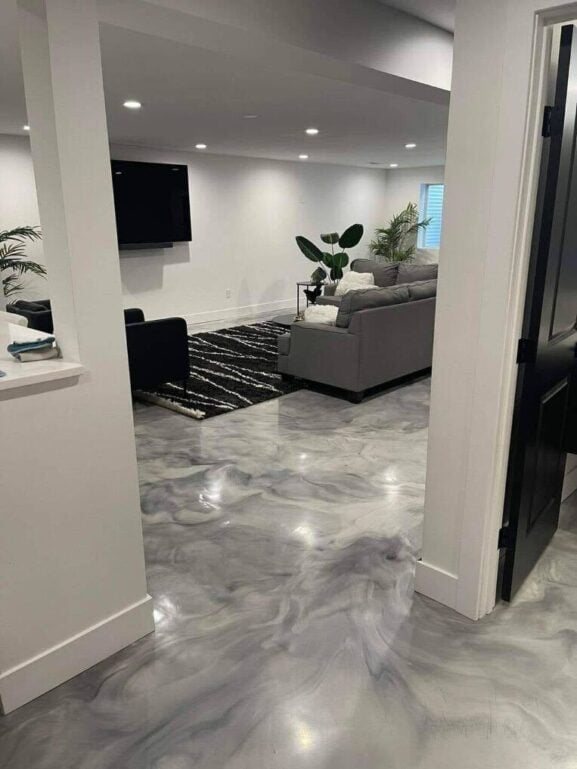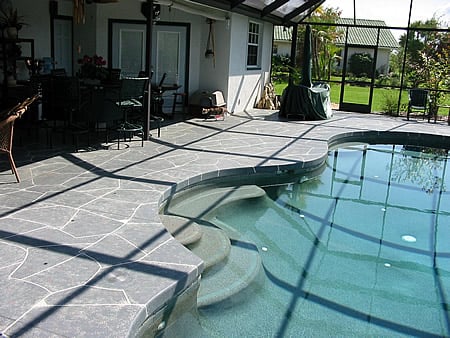Where Do Polished Concrete Floors Work Best In Sarasota?
- What are the benefits of polished concrete floors in residential settings in Sarasota
- How does polished concrete compare to other flooring options in terms of maintenance
- Can polished concrete floors be combined with other design elements like rugs or tiles
- What are the environmental benefits of choosing polished concrete floors in Sarasota
- How long does the polished concrete flooring process typically take
Polished concrete floors in Sarasota, FL, are suitable for both residential and commercial properties because of their durability, low maintenance, and sleek appearance.
Polished concrete is ideal for:
- Home interiors Homeowners use polished concrete in finished basements, kitchens, and living rooms. Newer homes may feature polished concrete throughout the entire first floor.
- Commercial and retail spaces Due to its durability and performance, polished concrete is a great flooring option for retail, commercial warehouses, and office facilities.
Some benefits of polished concrete floors:
- Aesthetics Polished concrete offers a smooth, glossy appearance that is both sleek and stylish. The gloss is light-reflective, which adds to the appeal, and it can be combined with stains in a wide range of colors.
- Durability Polished concrete strengthens the concrete, making it more resistant to wear and tear.
- Low maintenance Polished concrete is easy to clean and maintain.
- Eco-friendly Polished concrete floors contribute to healthier indoor air quality by minimizing dust and allergens. They are also energy efficient because they reflect light and reduce heating costs. Paradigm Concrete Finishes says that polished concrete and epoxy floors are the most environmentally conscious flooring solutions available.
What are the benefits of polished concrete floors in residential settings in Sarasota
Polished concrete floors offer numerous benefits for homeowners, including durability, design versatility, and low maintenance. They are also cost-effective and environmentally friendly.
Key advantages:
- Aesthetics They provide a sleek, modern look, complementing various interior design styles. The reflective surface can enhance natural and artificial lighting, making rooms appear larger and brighter.
- Durability Polished concrete is resistant to wear and tear, making it suitable for high-traffic areas and homes with pets or children. The hard surface doesn’t easily scratch or scuff.
- Low Maintenance Polished concrete floors are easy to clean and maintain, requiring only occasional sweeping and mopping. Unlike other flooring options, they don’t need regular sealing or waxing.
- Cost-Effectiveness Polished concrete can be more economical than alternatives like hardwood, tile, marble, or stone. The long-term savings on maintenance and replacement costs make it a smart choice.
- Eco-Friendliness Polished concrete utilizes the existing concrete slab, reducing the need for new materials. The process is energy-efficient, and the floors don’t require hazardous chemical coatings, cleaners, or adhesives.
- Health Benefits Polished concrete is a hypoallergenic flooring option because it doesn’t harbor allergens, dust, and dander. It also resists moisture damage and mold growth, improving indoor air quality.
How does polished concrete compare to other flooring options in terms of maintenance
Polished concrete floors are among the easiest flooring options to maintain, especially when compared to alternatives like tile, hardwood, and vinyl. Here’s how they compare:
Polished Concrete
- Maintenance Requirements: Minimal. Regular sweeping or dust mopping and occasional mopping with a neutral cleaner are sufficient. Polished concrete does not require waxing, stripping, or refinishing unless there is significant wear.
- Stain Resistance: Highly resistant to stains and spills when properly sealed, making it ideal for homes with children or pets.
- Longevity: Durable surface that requires less frequent repairs or replacements compared to other materials.
Tile Flooring
- Maintenance Requirements: Moderate. While tiles are easy to clean, grout lines require frequent scrubbing and resealing to prevent dirt accumulation and discoloration.
- Stain Resistance: Tiles resist stains well, but grout can absorb moisture and stains over time.
Hardwood Flooring
- Maintenance Requirements: High. Requires regular sweeping and mopping. Periodic refinishing is needed to restore its appearance and protect against scratches and dents.
- Stain Resistance: Susceptible to staining and damage from moisture or spills if not properly sealed.
Vinyl or Linoleum
- Maintenance Requirements: Intermediate. Requires regular cleaning and occasional waxing to maintain its appearance.
- Stain Resistance: Generally good but can degrade over time in high-traffic areas.
Natural Stone
- Maintenance Requirements: High. Needs regular cleaning with special products and periodic sealing to prevent moisture penetration and staining.
- Stain Resistance: Less resistant than polished concrete due to its porous nature unless sealed properly.
Summary
Polished concrete stands out for its low maintenance, stain resistance, and long-term cost-effectiveness. It requires less effort than tile (due to grout issues), hardwood (due to refinishing needs), or natural stone (due to sealing requirements), making it an excellent choice for both residential and commercial spaces.
Can polished concrete floors be combined with other design elements like rugs or tiles
Yes, polished concrete floors can be effectively combined with other design elements like rugs, tiles, or contrasting materials to enhance aesthetics and functionality. Here are some ways to integrate them:
Using Rugs
- Warmth and Comfort: Adding rugs to polished concrete floors softens their industrial look and provides warmth, making the space feel cozier.
- Design Flexibility: Rugs can introduce color, texture, and patterns, allowing for seasonal or stylistic changes without altering the floor itself.
- Practicality: Rugs can also be placed in high-traffic or standing areas (e.g., kitchens) to add comfort and reduce fatigue.
Combining with Tiles
- Transitions: Polished concrete can seamlessly transition into tiled areas, such as bathrooms or kitchens, creating a visually distinct yet cohesive look.
- Mimicking Materials: Polished concrete can be stained or patterned to mimic tiles, stone, or other materials for a unified design aesthetic.
Mixing with Other Flooring
- Contrast and Texture: Combining polished concrete with wood, brick, or other textured materials adds depth and contrast to a space. This approach balances the coldness of concrete with warmer surfaces.
- Cohesive Design: Using transition pieces ensures smooth integration between different flooring types, maintaining a cohesive style throughout the home.
Polished concrete’s versatility allows it to pair well with various decorative elements, making it an excellent choice for modern, rustic, or eclectic interiors.
What are the environmental benefits of choosing polished concrete floors in Sarasota
Polished concrete floors offer numerous environmental benefits, making them an eco-friendly flooring choice for both residential and commercial spaces:
Energy Efficiency
- The production of polished concrete requires less energy compared to other flooring options like tiles or vinyl.
- The reflective surface of polished concrete enhances natural light, reducing the need for artificial lighting and lowering electricity consumption.
- Polished concrete’s thermal mass properties help regulate indoor temperatures, potentially reducing heating and cooling costs.
Waste Reduction
- Polishing existing concrete slabs eliminates the need for additional flooring materials, reducing waste and conserving natural resources.
- The process generates minimal waste during installation, unlike carpet or vinyl flooring.
Improved Air Quality
- Polished concrete floors emit extremely low levels of volatile organic compounds (VOCs), promoting better indoor air quality.
- They do not harbor dust, bacteria, or support mold growth, making them ideal for individuals with allergies.
Durability and Longevity
- The long lifespan of polished concrete floors reduces the need for frequent replacements, minimizing environmental impact over time.
- Their durability makes them suitable for high-traffic areas, reducing maintenance and replacement frequency.
Sustainable Materials
- Concrete is made from abundant natural materials, and some types of eco-friendly cement incorporate recycled materials.
- Using local materials for concrete production can reduce transportation-related emissions.
Chemical Reduction
- Polished concrete floors can be maintained with non-toxic, neutral pH cleaners, reducing harmful chemicals in the waste stream.
- They eliminate the need for chemical stripping and rewaxing often associated with other flooring types.
By choosing polished concrete floors, businesses and homeowners can significantly reduce their environmental footprint while enjoying a durable, low-maintenance, and aesthetically pleasing flooring solution.
How long does the polished concrete flooring process typically take
The time required to polish concrete floors depends on several factors, such as the size of the area, the condition of the concrete, and the desired finish. Here’s a general breakdown:
- Small Projects (e.g., residential spaces like basements or living rooms): Typically take 2 to 5 days, depending on surface preparation needs and the level of polish desired.
- Larger or More Complex Projects (e.g., commercial spaces or decorative finishes): Can take 1 to 3 weeks or more, especially if extensive grinding, repairs, or high-gloss finishes are required.
- Surface Preparation: Floors in poor condition or with coatings (like paint or epoxy) may require additional time for cleaning, crack repair, and leveling, which can add a day or more to the process.
For smaller spaces with minimal preparation, the process may be completed quickly, but larger or more intricate jobs demand more time for precision and quality.



